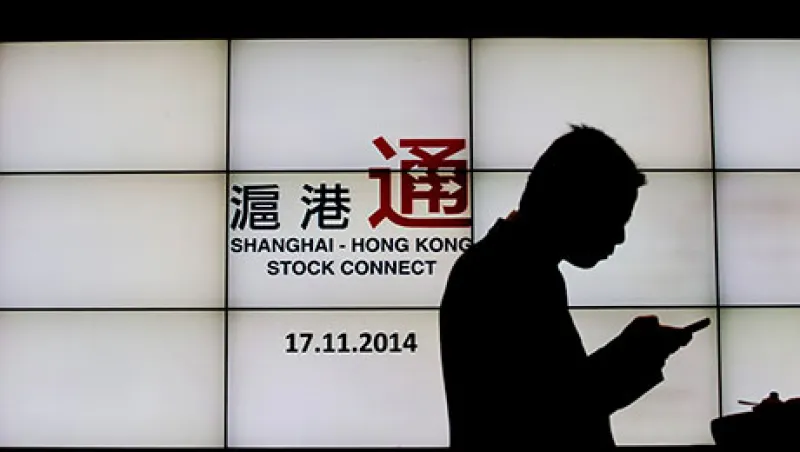All eyes among Asian equity investors were fixed on Shanghai last fall when China for the first time opened the city’s stock market to overseas retail investors. But five months later, the focus has shifted to a sudden surge in demand for Hong Kong–listed stocks from mainland investors.
Launched in November, the Shanghai-Hong Kong Stock Connect program is a tightly managed, two-way investment street that lets foreigners play the Shanghai Stock Exchange simply by going through a Hong Kong broker, and mainlanders trade on the Stock Exchange of Hong Kong. The arrangement, introduced after years of debate and speculation, represents one of the most significant liberalizations of China’s capital market in years.
After an initial burst of Shanghai stock buys by investors from around the world, however, traffic on the northbound side of the Connect street has moderated. Foreign buying of Shanghai stocks averaged 4.3 billion yuan a day ($700 million) in the first ten days after the Connect program opened in mid-November, slowed to 2.7 billion yuan a day in January and February and then rebounded a bit to 3.3 billion yuan in March, after the Chinese New Year holiday.
A recent report by Shanghai-based Z-Ben Advisors said northbound traffic on the Connect street was maturing, with flows from foreign investors “slowly transforming from momentum-led speculation to longer-term buy-and-hold.”
By contrast, southbound flows have surged lately. The average daily volume of all stock buying and selling by Chinese investors on the Hong Kong exchange through the Connect program was HK$14.7 billion ($1.9 billion) between April 1 and 15, or more than nine times the average daily turnover March, according to Hong Kong Exchanges and Clearing, the company that operates the exchange. On two days during that period, net buying by mainlanders hit the daily ceiling of 10.5 billion yuan set by Chinese regulators. Many analysts believe these outbound investment flows will continue to grow because they are consistent with the authorities’ plan for greater financial liberalization.
Several factors are driving the mainland investor interest in Hong Kong stocks. A huge rally in mainland stocks has made Hong Kong valuations more attractive. Shanghai’s SSE Composite index rose by 119 percent in the 12 months ended April 24, whereas Hong Kong’s Hang Seng index rose by just under 27 percent in that period, with most of the latter’s gain occurring since early March. Hong Kong–listed shares of Chinese companies, known as H shares, traded at 10.7 times earnings on average in March, compared with a price-to-earnings ratio of 20.5 for Shanghai-listed A shares. Analysts say Hong Kong has attracted a lot of buying interest from mainland hedge funds as well as from retail investors who have been behind the big Shanghai rally.
Regulatory changes are also fueling southbound investment flows. On March 27 the China Securities Regulatory Commission (CSRC) announced a policy change to give Chinese mutual funds greater access to the Hong Kong bourse. Also that month the China Insurance Regulatory Commission gave insurance companies permission to expand the scope of their investments to include the Growth Enterprise Market, an arm of the Hong Kong exchange that focuses on young growth companies. “Regulators encouraged institutional investors to buy Hong Kong stock,” says Lu Wenjie, China H share strategist at the Shanghai office of UBS Securities.
Chinese mutual funds have been booming of late, with new fund launches raising more than 364 billion yuan between January 1 and April 21, according to a recent report in the China Securities Journal. A good chunk of this money could go south. “The market currently estimates there may be more than 100 billion yuan in funds on the mainland ready to invest in Hong Kong stocks,” Chen Baixun, head of wealth management at Hong Kong–based Bank of East Asia, was quoted as saying in late April by the Shanghai Securities News.Mainland exchange-traded funds that track the Hang Seng index have also seen substantial investor inflows. In the first five trading days after the CSRC’s March announcement, the Easy Way to Reach Hang Seng H-shares ETF’s assets rose 31 percent, to 1.3 billion yuan, while the smaller Chinese Hang Seng ETF’s holdings jumped 43 percent, according to the state-run Securities Times newspaper. Both funds are managed by China Asset Management Co.
The authorities are expected to take more steps in the near future to broaden Chinese investors’ access to overseas markets, according to securities analysts and Chinese media reports.
State media have suggested that the authorities may launch a Shenzhen–Hong Kong cross-border stock investment program this year. Chinese officials have also hinted at possible tie-ups with overseas exchanges. Analysts say the Singapore Exchange is a potential partner for a Connect-like linkup with a mainland exchange.
Connect is an innovation that’s designed “to enhance the level of internationalization of our asset management industry,” Deng Ge, a spokesman for the CSRC, said recently. Hong Kong officials echo that point. “Stock Connect is more than just another simple investment channel,” Charles Li, CEO of Hong Kong Exchanges and Clearing, wrote in an April 9 blog entry. “Its real, lasting meaning will be in enabling Chinese investors to internationalize their asset allocation in order to grow their wealth over the long term.”
UBS Securities’ Lu says Connect is likely to be a first step toward giving mainland investors the power to play stock and even bond markets worldwide. “The general trend is definitely to liberalize cross-border investment,” Lu says. “Southbound investment is just a part of that.” He predicts regulators will open the cross-border investment window wider within a matter of months.
Deng told reporters in early April that Chinese and Hong Kong securities regulators were jointly studying a proposal to raise the Connect program’s trading limits. Current rules set net buying limits of 10.5 billion yuan for Chinese investors going into Hong Kong and 13 billion yuan for foreign investors going into Shanghai.
The quotas were originally set “to ensure the scheme got off the ground in a smooth and stable way,” said Hong Kong Exchanges’ Li. But with Chinese investors bumping up against the southbound quota limit, exchange officials “are urging authorities to quickly expand the quotas,” he added.
China’s market regulators “are looking to encourage firms to invest offshore and, as part of this, are looking to provide multiple access points to do so,” says Stephen Baron, Z-Ben Advisors’ deputy director of strategic solutions. He suggests that the Connect program could become the main vehicle for mainland investors to play the Hong Kong market, whereas the Qualified Domestic Institutional Investor program, which the authorities initiated in 2006 to enable Chinese institutions to invest in overseas markets, focuses on other foreign markets and becomes the means by which Chinese investors get “broader global exposure.”






